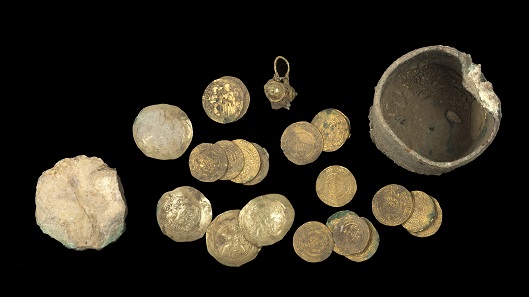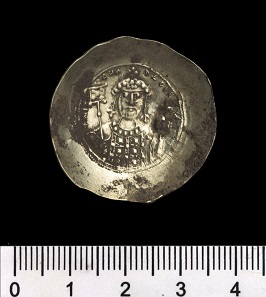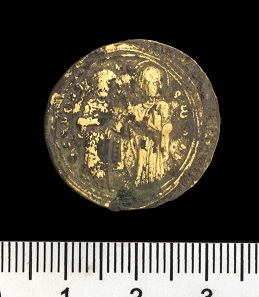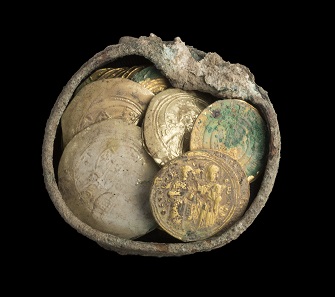January 24, 2019 – A rare and important treasure, a small bronze pot holding 24 gold coins and a gold earring, was uncovered at the Caesarea National Park. It was found during the NIS 150 million excavation and conservation project at the site, sponsored by the Edmond de Rothschild Foundation, in cooperation with the Caesarea Development Corporation, the Israel Antiquities Authority and the Israel Nature and Parks Authority. The gold cache was found hidden between two stones in the side of a well, located in a house in a neighborhood dating to the Abbasid and Fatimid periods, some 900 years ago.
Archaeologists from the Israel Antiquities Authority elaborated, “The cache is a silent testimony to one of the most dramatic events in the history of Caesarea – the violent conquest of the city by the Crusaders. Someone hid their fortune, hoping to retrieve it – but never returned.”
Mixed Fatimid-Byzantine hoard with bronze pyxis, dated to the end of the 11th century. The hoard also contained a filigree earring. In the photo on the left, the improvised ceramic stopper. Photo: Clara Amit, Israel Antiquities Authority.
According to the directors of the excavation, Dr. Peter Gendelman and Mohammed Hatar of the Israel Antiquities Authority, “The coins in the cache dating to the end of the eleventh century, make it possible to link the treasure to the Crusader conquest of the city in the year 1101, one of the most dramatic events in the medieval history of the city. According to contemporary written sources, most of the inhabitants of Caesarea were massacred by the army of Baldwin I (1100-1118), king of the Crusader Kingdom of Jerusalem. It is reasonable to assume that the treasure’s owner and his family perished in the massacre or were sold into slavery, and therefore were not able to retrieve their gold.”
Convex shaped nomisma histamenon of Michael VII Doukas (1071-1079). Photo: Clara Amit, Israel Antiquities Authority.
This important discovery was found close to the location of two other treasures of the same period. The first, a pot consisting of gold and silver jewelry, was discovered in the 1960s. The second, a collection of bronze vessels, was found in the 1990s. These treasures are currently displayed at the Israel Museum in Jerusalem.
At the center of the excavation and conservation activity of the multi-year Caesarea project, stands the impressive façade of the city’s ancient central public building. It was part of a sacred compound first built by Herod more than two millennia ago, as a tribute to his Roman patron, the emperor Augustus, and the goddess Roma. The newly discovered treasure was found in this area. The well where the treasure was found was part of a house within the Fatimid and Abbasid neighborhoods, built some 1,000 years after Herod’s reign, below the western façade of the Herodian temple. These neighborhoods also extended to parts of the inner harbor of the Caesarea port, which had already silted up by that time.
According to Dr. Robert Kool, coin expert at the Israel Antiquities Authority, “The cache is of a unique combination of coins not yet seen in Israel consisting of two types of coins: 18 Fatimid dinars, well known from previous excavations in Caesarea where it was the standard local currency of the time; and a small and extremely rare group of six Byzantine imperial gold coins. Five of the coins are concave and belong to the reign of the Byzantine Emperor Michael VII Doukas (1071-1079). These coins did not circulate locally, and hint at contacts, possible trade relations between Caesarea and Constantinople during the period. One or two of these gold coins were the equivalent of the annual salary of a simple farmer, so it seems that whoever deposited the cache was at least well-to-do or involved in commerce.”
Flat shaped nomisma histamenon of Romanos III Argyrus (1028 – 1034). Photo: Clara Amit, Israel Antiquities Authority.
Guy Swersky, Vice Chairman of the Edmond de Rothschild Foundation, comments: “This valuable discovery reaffirms the importance of the fund’s decision to allocate an unprecedented sum of more than NIS 150 million to conserve and restore the Old City and the port, making it accessible to hundreds of thousands of tourists from Israel and around the world. This is a project with economic significance for regional development, and another important contribution of the Rothschild Caesarea Foundation to the development of tourism and employment in the area.”
Michael Karsenti, CEO of the Caesarea Development Corporation, adds: “The treasure was discovered during the completion of a vast project we have been working on for more than two years: exposing the huge port vaults from the days of the peak of Caesarea’s glory. It is symbolic that the gold coins were discovered on the eve of Hanukkah. For us, this is certainly ‘Hanukah gelt,’ and a testament to how much more is still hidden within Caesarea. We invite the public to take advantage of the days of Hanukah to visit the site with their children and experience this fascinating find.” Karsenti emphasized that in addition to uncovering the treasures in the vaults of the Herodian Temple, development work continues at the site of the ancient synagogue whose mosaic floor has been partially restored.
Details of new hoard. Photo: Clara Amit, Israel Antiquities Authority.
Comments from Director General of the Nature and Parks Authority Shaul Goldstein: “Ancient Caesarea, which is preserved in all its splendor at the Caesarea National Park, never ceases to surprise, and reveals ever more of its exciting and fascinating history. For centuries following its founding, Caesarea stood out as a city of great importance. Even today, the National Park each year attracts hundreds of thousands of visitors from Israel and around the world; who enjoy a powerful and fascinating visitor experience. We, along with all of the entities involved in the conservation of the treasures and architectural richness of Caesarea National Park, have the duty and privilege to preserve the heritage of ancient Caesarea for the benefit of the entire public as well as for future generations.”
Israel Antiquities Authority director, Israel Hasson: “Since its founding 2,030 years ago, and throughput the periods which followed, Caesarea has been a vibrant port city. Its significance and architectural wealth have made it one of the most important cities of the Roman and Byzantine empires. The archaeological excavations carried out at the site on behalf of the Israel Antiquities Authority, which continue decades of earlier excavations, reveal many remains from the time of Herod until the Crusader period. In addition to the vast excavations at Caesarea National Park, the port is undergoing extensive conservation, restoration and development activities. The project is indeed one of the largest and most important conservation projects in Israel to date.”
Further information about the work of the Israel Antiquities Authority is available online.
A good impression of the location is found at BibleWalks.com








